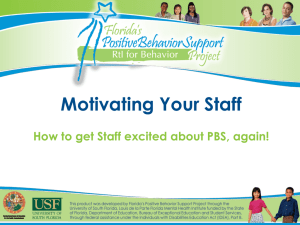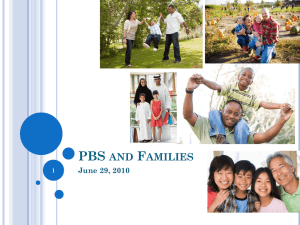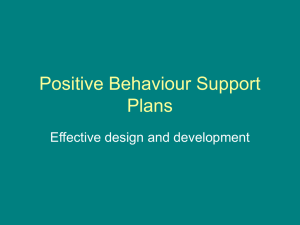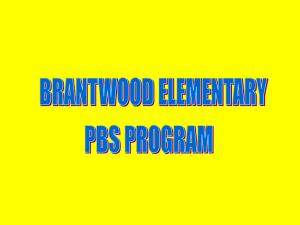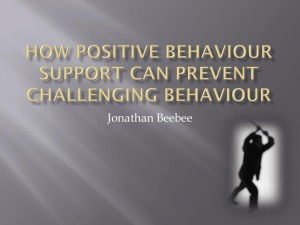Supplemental Tier 1 High Schools 6 8 10
advertisement
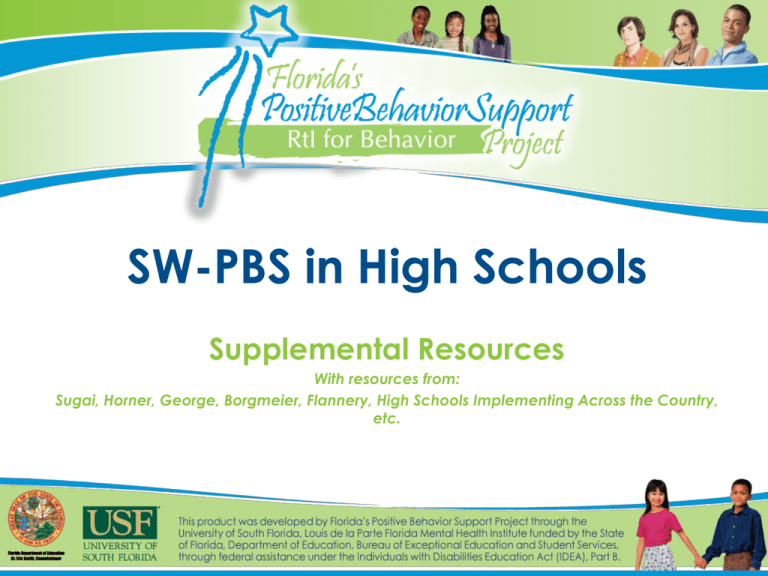
SW-PBS in High Schools Supplemental Resources With resources from: Sugai, Horner, George, Borgmeier, Flannery, High Schools Implementing Across the Country, etc. High Schools’ Concerns… • Low academic achievement • Antisocial school culture & behavior – Insubordination, dress code, language use, etc – Low attendance, tardies, substance use – Withdrawal, depression, emotional disturbances – Dropping out, substance use, delinquency • Graduation, careers, postsecondary • Social skill deficits 3 “Reinventing” What & How We Teach: The New 3 “R’s” for the 21st Century RIGOR High standards, content level and instruction Meeting needs of all students Focus on increasing student achievement Preparing students for post-secondary education, careers, life National High School Alliance RELEVANCE Helping students to understand why something is important to learn Fostering curiosity & life-long learning by providing students opportunities to explore learning that is personally relevant to them RELATIONSHIPS/RESPECT Students won’t learn or work hard for teachers who do not respect them You can’t motivate a student you don’t know Tony Wagner Predictable Reactive Responses • When we experience aversive situation, we select interventions that produce immediate relief by – Removing student – Removing ourselves – Modifying physical environment – Assign responsibility for change to student &/or others 5 Assumptions • Adolescents should know better…most do • Adolescent will “get it” & change…many do • Adolescents must take responsibility for own behavior….most know they should & do….appropriately & inappropriately • Punishment teaches right way….not really • Parents will take care of it…many try • Adolescents will learn from natural consequences….most do WHAT ABOUT NON-RESPONDERS? 6 So…How should we respond? •Positive, predictable school-wide climate •High rates of academic & social success •Formal social skills instruction •Positive active supervision & reinforcement •Positive adult role models •Multi-component, multi-year schoolfamily-community effort Surgeon General’s Report on Youth Violence (2001) Coordinated Social Emotional & Learning (Greenberg et al., 2003) Center for Study & Prevention of Violence (2006) White House Conference on School Violence (2006) 7 PBS: How High Schools Differ In General •School size varies •Teachers see role as teaching behavior and academics •Targeted behaviors are reflected in office referrals •Teacher-student relationships are easily formed •Easier to shape student behavior •Outcome is educational gradual progress In High School •Larger numbers of students and staff – Hierarchical management •Teachers see role as teaching academics- content focused •Targeted behaviors are reflected in attendance, performance, and office referrals •Impersonal atmosphere – lack of shared responsibility •Expectation of adult behavior •Outcome is educational mastery and competitive achievement – end outcomes •Student responsibilities: jobs, family 8 High School DVD: Chapter 3 9 Teaming 10 Administrative Leadership Be Knowledgeable & Involved • • • Inspire and promote a shared vision Acknowledge that change is hard Play an active and visible role – – Lip service won’t cut it; be an active team member Model PBS philosophy & practice with staff as well as students – – • Teach, redirect, reinforce Mindset & action is consistent with prevention & capacity building, instead of monitoring and control Get other administrators up to speed & involved 11 The High School PBS Core Team • Team members should be highly regarded and motivated staff • All members of core team must be knowledgeable and engaged – – – Willing to talk about PBS to other staff members Have time & ability to take on tasks to support initiatives Diversify personal strengths • Clear expectations for what team is to do • Team membership mostly stable from year to year 12 Preparing for Success • Reallocate resources • Schedule a common planning time • Data is accurate & up to date • Core team meetings are a priority • Plan for faculty & student input • Be willing to listen & explore conflict • Start with small concrete goals 13 High School DVD: Chapter 6 14 Teaching Expectations and Rules 15 Teaching Expectations In High School • Include students • Use variety of teaching methods • Do not rely on role play alone • Incorporated into instruction • Can include self-determination components • Prepare your staff to teach behavior 16 Ideas for Teaching Students • Use student leaders, Use Future Educators of America (FEA) to develop strategies • Survey students for suggestions & concerns • Use clips from popular movies • Pilot with a small group of students • Different lesson plans for upperclassman vs. lower • During advisory, homeroom, study hall • Independent student analysis of scenarios, classroom discussion with products, bell work • Student must developed product covering Student Code of Conduct (PowerPoint, video, poster, examples & non-examples • Art contests, “Graffti” wall • Scavenger hunts • Rolling video across TV screens, online modules Working with Subject Areas • Task force to ID specific ways expectations can be worked into existing curricula – Language arts, civics, social studies, statistics, general science, media – Solicit embedding ideas from all faculty and students • Make it easy for the rest of the faculty • Prepare your staff to teach behavior • Get their impressions of the lessons afterwards, too • Use homeroom, study hall, before/after school waiting areas; consider adding social skills class to schedule – Emphasize time saved with appropriate behavior 18 A High School Kick Off Timeline • Prior to the opening of school: Parents and Freshman/New Students invited to rotational meetings for academic & behavioral expectations • First three days of school: Orientation for returning teachers, new teachers, cafeteria staff, security guards, etc. • When school starts: Separate assembly for freshman; sophomores-seniors have refresher orientation 19 Folder: Teaching Appropriate Behavior •Variety of Lesson Plans (over 50) • • • • Respect Responsibility Readiness Student Code of Conduct • Social Injustice • • • • • Goal Setting Appropriate Language Acceptance Anti-Bullying Optimism 20 “Chuck Chuckerson” Video 21 Rewarding Students 22 Recognizing Students for Meeting Behavioral Expectations In High School •Rules vary across multiple settings •Students may contact many more staff on a daily basis •Behaviors of concern differ (attendance, tardy, etc.) •Rewards must be valued – HS students do like “hokey” things! •Do not try to solve academic deficiencies with behavioral rewards 23 To Reward, or Not To Reward? • Increase the likelihood that students will behave • Teaching tool • Increase opportunities to build positive adultstudent relationships, create positive climate • Encourage students to “take the next step” • Counteract negative peer influences • Shape intrinsic motivation 24 “PBS requires schools to use token economies” 25 Token Economies Benefits Drawbacks •Fast & Efficient feedback •Logistics can be intimidating •Flexible •Bridge to long-term reward •Counterfeiting worries •Faculty buy-in 26 27 28 School-Wide Behavior Bingo Be Respectful Homeroom Class 1 Class 2 Lunch Class 3 Class 4 Class 5 Class 6 Be Responsible Be Ready to Learn High School Reward Programs • • • • • • • • Tickets/tokens Stamps Bingo Cards Phone calls home “Fast passes” for cafeteria Tickets to school sporting events Parking spaces Dances 30 High School Reward Programs • • • • • • • • • • Buy back a tardy Shadow a teacher/administrator for a day Silent auction during lunch VIP/Hospitality Room at special events Preferred Parking Pass Music played over loudspeaker between classes Faculty/student sports competition Go to/Get out of Pep Rally Tailgating Party Seat Cushions 31 Rewarding Staff Earn Dollars to be redeemed for: • Free Lunch • Duty Free Week • No Bus Duty • No Morning Duty • Extra Planning Period • Wear Jeans • Get Out of Pep Rally 32 Other Ways to Reward Staff (Teachers hated attending •Class of the week: pep rallies) – Identified through •Homecoming Week: – Every teacher attending rally had name placed into drawing – 5 Winners received gift certificate to Denny’s – Additional recognition in newsletter administrator walk-throughs – One class per week nominated, based on outstanding instruction, student behavior and student work. – Announced on Wolf-TV and presented with a framed certificate pronouncing them 33 Class of the Week. Still More to Consider… • Web Resources: – Ideas for Free Incentives: http://flpbs.fmhi.usf.edu/revision07/schoolwide/schoolexamples/ Rewards-Incentives/Ideas%20for%20Free%20Incentives.pdf – Increasing the Effectiveness of Reward Systems (non-token economy based): http://flpbs.fmhi.usf.edu/revision07/schoolwide/schoolexamples/ RewardsIncentives/Increasing%20the%20Effectiveness%20of%20Rewa rd%20Systems.pdf – Add Laura Riffel Ideas 34 Folder: School-Wide Reward Systems •Positive Student Referral •Reinforcement Planning Matrix •Celebration Survey •Reward Procedures •Rationale for Acknowledging Students •Viking of the Month •List of Non-Cost Reinforcement Ideas 35 PBS DVD Rewarding Staff 36 Effective Discipline Procedures a) b) c) d) Definitions Office Discipline Referral Forms Developing a Coherent Office Discipline Referral Process Developing Effective Responses to Problem Behavior 37 Responding to Problem Behavior In High School •Office vs. Class vs. Dean vs. Security must be clear • Consistency is difficult (teacher and administrator) • Do not forget tardies- attendance • Prepare your staff to redirect not confront/ combat students •See Negative Consequences Examples from Folder 38 Establish a Philosophy •Prepare your staff to redirect, not confront or combat students •Shift in mindset from monitoring & control to prevention & capacity building •Kids want to succeed, adults want to help them be successful •Evaluate the values reflected in your current discipline policies •“3 Strikes & You’re Out” doesn’t help kids graduate •See Negative Consequences Examples from Folder 39 Thinking Outside the Box • Loss of Privileges (temporary) • Parking • Participating sports, clubs, productions, etc. • Academic Web-Based ISS • Mini-modules • Student studies (often independently) a specific topic • Combination of videos, readings, research, etc. • YouTube, popular movies, TV shows, etc… • Blackboard, Illuminate, I-Tunes, etc… • Consider a test on the content of the course 40 Thinking Outside the Box • • • • • • • • Community Service/Service Learning Behavior Contracts Restitution Restorative Justice Peer Mediation/Teen Court Referral to Community Agencies/Diversion Programs “New and Improved” ISS, Saturday School, Detentions Back Pack Club 41 Folder: Effective Discipline Procedures •Staff Incident Reports •Lansdowne High Flowchart •Negative Consequence Examples 42 Implementation 43 Pre-Training Steps • Administrator must express buy-in • Identify volunteers for team – May or may not have staff representation • Form team • Team identifies areas to target in upcoming year – Buy-in, specific setting, parent support – Use data • Formulate implementation plan 44 Universal Leadership Teams In High School •Facilitate buy-in – may be difficult across grades, learning communities, departments •Size and distribution of leadership •Utilize departmental structures •Account for diverse philosophies of education 45 Staff and Student Participation In High School • Challenges • Staff expectations for teaching academics Staff expectations concerning discipline Behavioral data are not public and values Differences in personal, political views Staff understanding of SWPBS Use data, stories from other high schools, pilots within your school Student involvement Consider student team or student members on the core team Student leaders should be given public roles 46 Student and Parent Involvement • Student buy-in will change faculty behavior – Build student involvement: student PBS team – Student leaders should be given public roles • Parental support will foster relationships between school, students, and faculty – Greater support for administrative and faculty decisions • Get input and make changes based on results 47 Building Staff Buy-In In High School • Main focus of activities prior to training • May take a year or longer to obtain 80% • Ensure involvement of all stakeholders – Parents – Students 48 Build Staff Buy-In Prior to Implementation • Main focus of activities prior to training • May take a year or longer to obtain consensus • Start with pre-implementation surveys: – what works/ what doesn’t – what are the school’s perceived priorities • Ensure involvement of all stakeholders – Parents – Students 49 Handout 50 Buy-In During Implementation • Start small (biggest bang for your buck) • Have an implementation plan • Team meetings • Weekly, monthly rewards • Least amount of work for faculty • Focus on one setting or behavior • Use data to determine starting point • Small reward component • • • • • Have baseline data Make it clear & easy Reward staff behavior Share outcome data and celebrate success Survey staff AND make changes based on survey results Buy-In Strategy • Do the “Data Walk” – Post graphs of different kinds of data around the room (demographics, attendance, classroom, achievement, kids re-taking courses, time in counselors’ offices, climate, graduation, etc…) – Staff walks through in small groups, create hypotheses for a selection of graphs (2-3?) – PBS Team uses ideas in their problem-solving meetings, and during faculty buy-in presentations 52 Implementation Strategies • Get your heads together – 1 year planning to build administrator and faculty buyin prior to roll-out and training • Implement one grade level, hallway, subject area, etc… at a time • Develop internal and external PBS Coaches • Extended training to accommodate the larger school-based teams • Continued and frequent social skills groups across all staff and students 53 Ongoing Professional Development is Required • PD is tied to data • Allocate PD days (full and/or partial) to PBS topics; and/or include PBS in established topics • Teachers will need additional info on: – – – – Classroom implementation Verbal de-escalation Behavior basics, effective consequences Activities to build philosophical consensus • Be a participant • In-service new teachers on SWPBS 54 High School DVD: Chapter 4 55 High School DVD: Chapter 5 56 Folder: Implementing Tier 1 •Lebanon High School Teacher Handbook •Focusing PBS on Adults •Survey •High School Top Ten •PBS in Florida High Schools •Student Voice Project •PBS in High Schools: Notes from Video •Parent Flyer 57 Evaluation 58 Emphasize Data • • • • • Faculty won’t buy into a new practice unless they understand why it’s being implemented (buy-in) Consider different kinds of data: dropouts, retaking courses, truancy, etc… Use the problem-solving process for behavior and academics - Core team makes recommendations to faculty, they may accept, or amend & implement At least 1-2x/month, look at fidelity & effectiveness (are we doing what we said we would, & is it working?). Identify weak system components 59 High School DVD: Chapter 8 60 Folder: Evaluation •PBS Newsletter •Developing Early Warning Systems to Identify Potential High School Dropouts •Another piece of data to analyze •Is Tier 1 having a positive impact on students who are at-risk for dropping out? •Students who may need more than Tier 1 61 Classroom PBS 62 Classroom Management In High School • Prepare staff • Discipline with dignity • Pre-teach, teach and re-teach • Effective use of humor 63 High School Articles •HIGH SCHOOL SWPBS IMPLEMENTATION: •Bohanon, H., Eber, L., Flannery, B., & Fenning, P. (2007). Identifying a roadmap of support for secondary students in school-wide positive behavior support applications. International Journal of Special Education, 22(1), 39-59. •SECONDARY/CLASSROOM SUPPORTS IN HIGH SCHOOLS: •Moroz, K., Fenning, P., & Bohanon, (under review) The Effects of guided practice, publicly posted feedback, goal setting, and acknowledgement on classroom tardies in an urban high school implementing school wide positive behavioral supports. •HIGH SCHOOL DISCIPLINE POLICIES AND PBS: •Fenning, P., Golomb, S., Gordon, V., Kelly, M., Scheinfield, R., Banull, C. et al. (in press). Written discipline policies used by administrators: Do we have 64 sufficient tools of the trade? Journal of School Violence. Before Getting to Work… 65 High School DVD: Chapter 12 66 Windsor High School DVD 67
